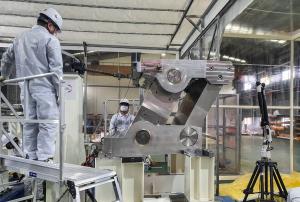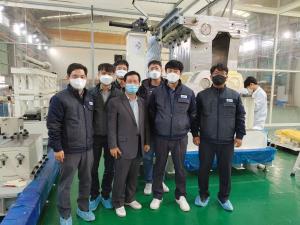Completion of the first vacuum vessel gravity support
The factory acceptance test on the first ITER vacuum vessel gravity support has been successfully completed at Haneul Engineering in Gunsan, Korea. Under the 8,500*-tonne plasma chamber, nine gravity supports will allow for the vacuum vessel's thermal expansion and sustain loads in the radial, toroidal and vertical directions.
Nine vacuum vessel gravity supports will be installed between the cryostat toroidal pedestal and the lower port of each vacuum vessel sector.
These supports are specially designed** to allow radial movement to accommodate the thermal expansion of the vacuum vessel that is caused by the temperature difference between initial assembly and operation, while maintaining high rigidity in the toroidal and vertical directions in order to withstand the dead weight of the tokamak, thermal loads, electromagnetic loads, plasma disruptions such as vertical displacement events, and seismic loads.
In the supports' dual-hinge structure, radial movement is permitted by the rotation of dowels, while toroidal and vertical movement is restricted by the rigidity of the dowels and that of the primary hinge. The possibility of 15º inclination introduces radial reaction force that provides centering to the stable equilibrium state of the ITER vacuum vessel.
On 12 November 2021, the factory acceptance test on the first vacuum vessel gravity support (for sector #6) was successfully completed at the Haneul Engineering (subcontractor of Hyundai Heavy Industries). Due to the ongoing pandemic, an official ceremony could not be held. However, the Director-General of ITER Korea, Kijung Jung, and a dozen experts were able to attend a small ceremony to congratulate the team on the successful completion of the first support and to celebrate industry involvement in fusion research.
The most critical step was dowel assembly—not only because the required tolerances for each hole of the upper block, lower block, primary hinge, and the dowels is only 0.02 mm, but also because the surface of dowels is coated with a very thin layer of MoS2 (20±3µm). Because the purpose of the MoS2 coating is to reduce and to sustain the friction coefficient during ITER operation, the coating on the dowels cannot be scratched or otherwise removed, making the precise assembly of the dowels very challenging. In order to increase the confidence in dowel assembly, pre-tests were performed with dummy dowels and a 1:1 scale mockup. Based on the results from these tests, the optimized setting value was fixed and the blocks and the dowels were set on the gravity support assembly jig. After several rounds of 3D measurements to aid in the precise alignment of the blocks, the dowel was successfully assembled.
After assembly, a functional test of vacuum vessel gravity support #6 was performed to verify whether full design movement (5° to 27°) could be achieved without excessive force. During the test, the upper block of the gravity support was moved from 5° to 27.05° very smoothly. Values of 1,385 kgf (maximum push force) and 2,410 kgf (maximum pull force) were recorded during the push operation (5° to 27.05°) and pull operation (27.05° to 5°) respectively.
With the completion of the factory acceptance test, vacuum vessel gravity support #6 can be prepared for delivery to the ITER site in March 2022.
*The double-walled ITER vacuum vessel weighs 5,200 tonnes. With the installation of the blanket and the divertor, as well as components such as the port plugs and diagnostics, the total weight rises to 8,500 tonnes.
** Vacuum vessel gravity supports are classified as Safety Important Components and as ITER Quality Class 1. The supports are non-pressure bearing equipment; however, as they support the vacuum vessel (Level N2 Cat IV Nuclear Pressure Equipment) they are considered part of this equipment. Design, manufacturing, and testing must comply with the applicable parts of the French regulation on pressure equipment. Design, analysis, and fabrication of the vacuum vessel gravity supports must follow RCC-MR rules for supports (RCC-MR subsection H).



